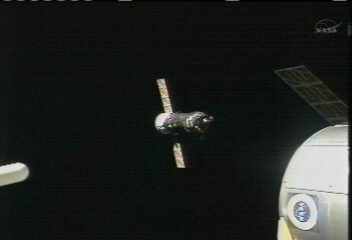After a flawless launch, an unmanned Russian Progress resupply ship used a new expedited technique to reach the International Space Station in hours instead of days. Progress 48 was loaded with almost three tons of food, fuel and supplies for the six crew members, and it docked successfully to the Pirs docking compartment on August 1, just six hours after the launch from the Baikonur Cosmodrome in Kazakhstan at 19:35 UTC (3:35 p.m. EDT, 1:35 a.m. Aug. 2 Baikonur time). The fast trip and rendezvous was designed to test a method for conducting additional firings of the Progress engines early in its mission to expedite the time required for a Russian vehicle to reach the complex.
Russian officials say the technique could be applied to manned Soyuz vehicles in the future to improve crew comfort and extend the life of the Soyuz return vehicle.
Russian cosmonaut Gennady Padalka has been quoted as saying it is every cosmonaut's dream to only have a 6-hour flight in the cramped Soyuz!
Russian engineers and managers are still assessing the new technique, but by all appearances the quick trip seemed to be a great success. This Progress vehicle will stay at the ISS until December.
During the docking, NASA also tested a new technique of attitude control for the ISS which will save fuel, requiring 10 times less fuel to put the station in the proper orientation relative to Earth for the unpiloted cargo vehicle's arrival.
According to Pooja Jesrani, lead attitude determination and control officer (ADCO) for this expedition at the Mission Control Center in Houston, the new maneuver is called the optimal propellant maneuver, or OPM. OPM is an improvement on the standard zero propellant maneuver, or ZPM, also developed by Draper Laboratory. The OPM takes into account the need to make the orientation, or attitude, changes to the space station faster than the ZPM. This speed avoids thermal concerns on the exterior of the station's modules.
"Maneuvers such as the OPM will increase the International Space Station's efficiency by using less propellant," Jesrani said. "Additionally, the reduction in thruster firings during an OPM results in the station enduring lower structural loads. These benefits, among others, will help increase the longevity of the station."
The maneuvers to and from the docking attitude are expected to save more than 90 percent of the fuel typically used when a Russian cargo spacecraft docks with the orbiting outpost.
Source:
NASA
 Universe Today
Universe Today
